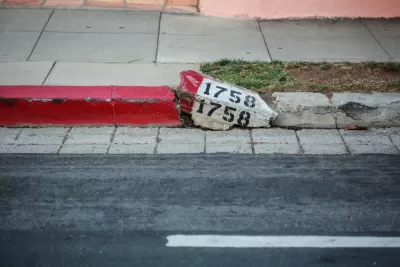Parking guru Donald Shoup discusses how the city of Los Angeles can fix its roughly 4,300 miles of sidewalk that require some degree of repair, for free.

According to a recent Op-Ed by Donald Shoup in the Los Angeles Times, "the city of Los Angeles has 10,750 miles of public sidewalks, and about 40% need some degree of repair, which the city estimates will cost at least $1.5 billion." Los Angeles got itself into this predicament after shifting sidewalk repair liability in 1973 from the state and owners of abutting properties to the city. In 1976 though, funding dried up and since then Los Angeles has resorted to either patching asphalt on cracked sidewalk, or more likely, nothing at all.
Shoup suggests Los Angeles can learn from cities like Pasadena and Piedmont, which mandate property owners fix abutting broken sidewalks when selling the property, also known as point-of-sale program. Point-of-sale programs have precedent in Los Angeles, as property owners are currently required to install a low-flow flush toilets before selling the property. For this to work, "before a property is sold, the city inspects the sidewalk fronting the property. If the inspector finds a broken sidewalk that is unsafe, the owner must fix it before the sale is final."
Shoup discusses some of the advantages of this program, such as raising property sale value and neighborhood values.
FULL STORY: A big step toward safer sidewalks

Planetizen Federal Action Tracker
A weekly monitor of how Trump’s orders and actions are impacting planners and planning in America.

Maui's Vacation Rental Debate Turns Ugly
Verbal attacks, misinformation campaigns and fistfights plague a high-stakes debate to convert thousands of vacation rentals into long-term housing.

Restaurant Patios Were a Pandemic Win — Why Were They so Hard to Keep?
Social distancing requirements and changes in travel patterns prompted cities to pilot new uses for street and sidewalk space. Then it got complicated.

In California Battle of Housing vs. Environment, Housing Just Won
A new state law significantly limits the power of CEQA, an environmental review law that served as a powerful tool for blocking new development.

Boulder Eliminates Parking Minimums Citywide
Officials estimate the cost of building a single underground parking space at up to $100,000.

Orange County, Florida Adopts Largest US “Sprawl Repair” Code
The ‘Orange Code’ seeks to rectify decades of sprawl-inducing, car-oriented development.
Urban Design for Planners 1: Software Tools
This six-course series explores essential urban design concepts using open source software and equips planners with the tools they need to participate fully in the urban design process.
Planning for Universal Design
Learn the tools for implementing Universal Design in planning regulations.
Heyer Gruel & Associates PA
JM Goldson LLC
Custer County Colorado
City of Camden Redevelopment Agency
City of Astoria
Transportation Research & Education Center (TREC) at Portland State University
Jefferson Parish Government
Camden Redevelopment Agency
City of Claremont





























